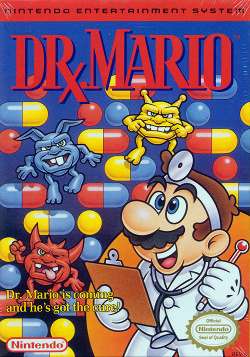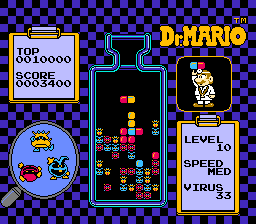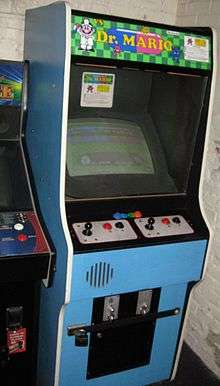Dr. Mario
| Dr. Mario | |
|---|---|
 Box art | |
| Developer(s) | Nintendo Research & Development 1 |
| Publisher(s) | Nintendo |
| Producer(s) | Gunpei Yokoi[1] |
| Designer(s) | Takahiro Harada[2] |
| Composer(s) | Hirokazu Tanaka[3] |
| Series | Dr. Mario |
| Platform(s) | NES, Nintendo VS. System, PlayChoice-10, Game Boy, Game Boy Advance |
| Release date(s) | |
| Genre(s) | Puzzle |
| Mode(s) | Single-player, multiplayer |
Dr. Mario (Japanese: ドクターマリオ Hepburn: Dokutā Mario, often stylized as D℞. Mario) is a 1990 Mario arcade-style action puzzle video game produced by Gunpei Yokoi and designed by Takahiro Harada. Nintendo developed and published the game for the Nintendo Entertainment System and Game Boy consoles. The game's soundtrack was composed by Hirokazu Tanaka.
The game focuses on the player character Mario, who assumes the role of a doctor and is tasked with eradicating deadly viruses. In this falling block puzzle game, the player's objective is to destroy the viruses populating the on-screen playing field by using colored capsules that are dropped into the field. The player manipulates the capsules as they fall so that they are aligned with viruses of matching colors, which removes them from play. The player progresses through the game by eliminating all the viruses on the screen in each level.
Dr. Mario received positive reception, appearing on several "Best Nintendo Games of All Time" lists. The game has been ported, remade, or has had a sequel on every Nintendo home console since the NES as well as most portable consoles, including a re-release in 2004 on the Game Boy Advance as part of the Classic NES Series. Modified versions of Dr. Mario exist as minigames in WarioWare, Inc.: Mega Microgames!, Brain Age 2: More Training in Minutes a Day!, and Brain Age: Concentration Training.
Gameplay

Dr. Mario is a falling block tile-matching video game,[9] in which Mario assumes the role of a doctor, dropping two-colored medical capsules into a medicine bottle representing the playing field. This area is populated by viruses of three colors: red, yellow, and blue. In a manner and style considered similar to Tetris,[10] the player manipulates each capsule as it falls, moving it left or right and rotating it such that it is positioned alongside the viruses and any existing capsules. When four or more capsule halves or viruses of matching color are aligned in vertical or horizontal configurations, they are removed from play; any remaining capsules or capsule halves which are not supported by a virus, capsule, or the bottom of the playing field immediately below will then fall as far as needed until it lands on one, after which any new 4-in-a-row alignments created from this will be removed. The main objective is to complete levels, which is accomplished by eliminating all viruses from the playing field. A game over occurs if capsules fill up the playing field in a way that obstructs the bottle's narrow neck.[11]
Players can select the degree of starting difficulty any time a new game is started. The initial level chosen is a value between zero and twenty that determines the number of viruses to clear, and the three game speed options change how fast the capsules fall in the bottle. The player's score is based solely on the elimination of viruses, not on the time taken to complete the level or the number of capsules used. If players complete the highest difficulty level, they can continue playing to accumulate a higher score, but the number of viruses to clear remains the same. Additional points are awarded when multiple viruses are eliminated at once, but no additional points are awarded for initiating chain reactions, in which the elimination of one set of objects triggers the elimination of another set. The game speed is also a factor in how the game calculates scoring; higher speed levels yield more points.[11]
Dr. Mario offers a multiplayer gaming mode in which two players compete against each other in separate playing fields. In this mode, the player's goal is to clear their own playing field of viruses before the other player does. Eliminating multiple viruses or initiating chain reactions can cause additional capsules to fall onto the opponent's playing field. A player wins a single game upon eliminating all the viruses or if the other playing field fills up. The first player to win three games wins overall.[11]
Development and releases

Dr. Mario was produced by Gunpei Yokoi, creator of the Game Boy and Game & Watch handheld systems,[1] and designed by Takahiro Harada, who also acted as producer of the Metroid series.[2] The game's music, later re-used and arranged in games such as Super Smash Bros. Melee, was composed by Hirokazu Tanaka, who later became president of Creatures Inc., an affiliate of Nintendo that owns one-third of the copyright regarding the Pokémon franchise.[3]
Re-releases
Dr. Mario spawned a number of remakes and ports that were released on various Nintendo consoles. The original version's multiplayer portion was ported to two Nintendo arcade systems in 1990: the Nintendo Vs. System (under the title Vs. Dr. Mario) and the PlayChoice-10.[5][6]
An enhanced remake of Dr. Mario was paired with Tetris in the Super Nintendo Entertainment System compilation game Tetris & Dr. Mario, released on 30 December 1994.[12] This version of Dr. Mario was re-released in Japan on 30 March 1997, as a downloadable title for the Super Famicom's Satellaview peripheral, under the name Dr. Mario BS Version (Dr.マリオBS版 Dokutā Mario Bī Esu Ban).[13] It was re-released again in Japan as a downloadable game for the Super Famicom's and Game Boy's Nintendo Power cartridges.[14][15]
The NES version was ported twice to the Game Boy Advance: first in 2004 as one of thirty games in the Classic NES Series (known as the Famicom Mini Series in Japan),[16] then bundled with a version of the Puzzle League series in 2005 under the title Dr. Mario & Puzzle League, this time with updated graphics and new music to choose from.[17] On 20 May 2003, Nintendo released the "Nintendo GameCube Preview Disc" for the Nintendo GameCube, which allows players to download the NES version of Dr. Mario to their Game Boy Advance consoles using the Nintendo GameCube – Game Boy Advance link cable.[18]
The original Game Boy version was made available on the Nintendo 3DS Virtual Console in 2011 and 2012.[8] The NES version was released on the Wii U Virtual Console in 2014.[19]
Reception
| Reception | ||||||||||||||||||||||||||
|---|---|---|---|---|---|---|---|---|---|---|---|---|---|---|---|---|---|---|---|---|---|---|---|---|---|---|
| Classic NES Series: Dr. Mario (GBA) | ||||||||||||||||||||||||||
| ||||||||||||||||||||||||||
Dr. Mario and its re-releases received generally positive reviews, although some parents were critical of its premise due to its inclusion of medicine in a children's game.[29] One notably negative review, by ACE, scored the Game Boy version 510/1000. It criticized the game's uninspiring graphics and repetitive play. The review also said the game "reeks of plagiarism", stating it is worse than the original games it is modeled after.[30]
Reviewing the NES version, Allgame praised it, stating that on its release, "when puzzle games were flooding the market, Dr. Mario stands out as one of the best, combining a smooth learning curve, playful graphics and memorable tunes" and "fundamental concepts may be simple, but the addictive gameplay becomes progressively more complex as the speed increases and additional viruses are added."[22]
GamePro gave the Tetris & Dr. Mario compilation a rave review. They praised the Mixed Match mode and the SNES enhanced graphics and sounds, and concluded "Sharp controls and absorbing action are what make these two classics even better as a pair than they were alone."[31] Next Generation, in contrast, said the compilation was only significant for being the first appearance of Tetris on the SNES, summarizing that "Yeah, it's great, but chances are you own a copy of one or both of these games already." They did, however, praise Nintendo for having the "cajones" to package their Tetris-inspired game with Tetris itself.[27]
Dr. Mario was rated the 134th best game released on a Nintendo system in Nintendo Power's Top 200 Games list,[32] by ScrewAttack as the seventh best Mario game of all time,[33] and by IGN as the 51st best NES game of all time.[34] IGN also rated the game's soundtrack, composed by Hirokazu Tanaka, as seventh in its list of the top ten greatest 8-Bit soundtracks.[35] GamesRadar ranked it the 13th best NES game ever made. The staff called it "one of the most celebrated of the [puzzle] genre."[36] Game Informer's Ben Reeves called it the seventh best Game Boy game.[37]
The Game Boy Advance re-release as part of the Classic NES series holds a rating of 66% on Metacritic based on 10 reviews.[21] Most reviews pointed out the game's addictiveness and praise the addition of wireless multiplayer, but some questioned the relevance of the game's re-release as a standalone title. Eurogamer said the game was "still as playable, addictive and maddening as it was back in 1990" but criticized Nintendo for re-releasing classic games as standalone titles in the Classic NES Series instead of as a compilation, like Atari's Atari Anthology or Midway's Midway Arcade Treasures.[38] Craig Harris, in his review for IGN, sarcastically expressed unease over the game's use of medicine. He enjoyed the addictive gameplay, but criticized the black-and-white manual which made it difficult to understand the color-based gameplay mechanics.[24] While 1UP.com noted that the game's "color-matching action is more engrossing than Mario Bros.' turtle-punching platform hopping", the reviewer strongly questioned whether this re-release is worth its sale price by itself when a version of Dr. Mario was included in another Game Boy Advance game, WarioWare, Inc.: Mega Microgames!.[39]
Legacy
Following the commercial success of this game, Nintendo released several follow-up titles in the Dr. Mario series. Dr. Mario 64, released in 2001 for the Nintendo 64, features Wario and several Wario Land 3 characters, and offers numerous game modes, including a story-focused single-player mode. The game also supports simultaneous multiplayer for up to four players at once. Dr. Mario 64 was subsequently released in Japan in the compilation game Nintendo Puzzle Collection on the Nintendo GameCube. Dr. Mario Online Rx, released in 2008 on WiiWare, offers online multiplayer via Nintendo Wi-Fi Connection. Dr. Mario Express, released in 2009 for the Nintendo DSi, does not support multiplayer gameplay. Dr. Luigi, released in 2013, features Luigi as a playable character and has all the modes in Dr. Mario Online Rx, as well as a new mode with L-shaped capsules. The latest installment, Dr. Mario: Miracle Cure, was released 2015 and introduced power-ups to the series.
The character of Dr. Mario appears as an unlockable playable character in the 2001 fighting game Super Smash Bros. Melee, where he attacks by throwing capsules known as "Megavitamins".[40] There are two ways to unlock Dr. Mario as a playable character, either by completing Classic, Adventure or All-Star mode with Mario (using no continues) or by completing 100 melee battles.[41] The game's sequel, Super Smash Bros. Brawl, does not feature Dr. Mario as a playable character, but it includes the Melee remix of Dr. Mario's "Fever" background music theme and a version of the "Chill" theme music arranged by Masaaki Iwasaki, who had previously composed for Magical Drop as part of the Data East Sound Team.[42][43] Dr. Mario characters also appear in the game as collectible stickers. Dr. Mario would later return as an unlockable playable character in Super Smash Bros. for Nintendo 3DS and Wii U.
A version of the game called Dr. Wario, which replaces Mario with Wario, is included as an unlockable minigame in WarioWare, Inc.: Mega Microgames!.[44] A simplified version of Dr. Mario also appears in Brain Age 2: More Training in Minutes a Day! as a minigame called "Virus Buster", which is played by using the system's touch screen to drag the capsules around the playing field.[45]
The viruses appear as enemies in Mario & Luigi: Superstar Saga and Mario & Luigi: Dream Team. In that game, they change colors every time they are attacked, and they are all defeated when they are all the same color, in a similar fashion to how they are defeated by the same color of the capsules in Dr. Mario.[46]
The characters of Dr. Mario and the viruses appeared in print media numerous times: Valiant published a volume of Nintendo Comics System's entitled The Doctor Is In... Over His Head, Dr. Mario also makes a brief appearance in the first volume of Super Mario-Kun, and the viruses also appear at the end of Super Mario Adventures.[47]
References
- 1 2 "You're Pretty Negative!". Shigesato Itoi Asks in Place of Iwata: Super Mario Bros. 25th Anniversary. Nintendo of America, Inc. September 24, 2010. Retrieved September 25, 2010.
- 1 2 "Producer Takahiro Harada on Wario Land: Shake It!". GameSpy. November 20, 2008.
- 1 2 "Hirokazu Tanaka's Works" (in Japanese). Sporadic Vacuum. Retrieved November 21, 2011.
- ↑ "Dr. Mario". TMK. Retrieved November 13, 2011.
- 1 2 "Vs. Dr. Mario". Arcade-Museum.com. Retrieved November 21, 2011.
- 1 2 "Dr. Mario". Arcade-Museum.com. Retrieved November 21, 2011.
- 1 2 "Dr. Mario Game Boy". IGN. Retrieved December 10, 2011.
- 1 2 "Dr. Mario (3DS Virtual Console / Game Boy)". NintendoLife. Retrieved November 6, 2011.
- ↑ Juul, Jesper (1 December 2007). "Swap Adjacent Gems to Make Sets of Three: A History of Matching Tile Games". Artifact. 1 (4): 205–216. doi:10.1080/17493460601173366. Retrieved 29 January 2012.
- ↑ Dillon, Tony (November 1990). "Dr Mario". ACE (38): 91.
Describing how the game works is best done by taking Tetris, adding Connect 4 and throwing in Dominoes.
- 1 2 3 Dr. Mario Instruction Booklet. Nintendo. 1990. NES-VU-USA.
- ↑ "Tetris & Dr. Mario". IGN. Retrieved 13 November 2011.
- ↑ "BS Dr. Mario". TMK. Retrieved 13 November 2011.
- ↑ "Dr. Mario" (in Japanese). Nintendo. Archived from the original on 23 October 2006. Retrieved 17 December 2011.
- ↑ "Dr. Mario" (in Japanese). Nintendo. Archived from the original on 16 September 2006. Retrieved 17 December 2011.
- ↑ Harris, Craig (16 April 2004). "Famicom Mini Series 2". IGN. Retrieved 10 October 2011.
- ↑ Burner, Rice (5 December 2005). "Dr. Mario & Puzzle League". GamePro. Archived from the original on 10 November 2009.
- ↑ "Nintendo GameCube Preview Disc (Cube)". GameSpy. Retrieved 14 December 2011.
- ↑ "At Mushroom Kingdom Hospital, nasty viruses are on the loose.". NintendoLife. Retrieved 21 October 2014.
- ↑ "Classic NES Series: Dr. Mario". GameRankings. Retrieved 2 December 2011.
- 1 2 "Classic NES Series: Dr. Mario". MetaCritic. Retrieved 2 December 2011.
- 1 2 Miller, Skyler. "Dr. Mario - Overview". Allgame. Archived from the original on 14 November 2014. Retrieved May 6, 2015.
- ↑ Bob Colayco (3 November 2004). "Classic NES Series: Dr. Mario Review".
- 1 2 Craig Harris (26 October 2004). "Dr. Mario (Classic NES Series)".
- ↑ "Simple, but infinitely fun". Nintendo Power (186): 148. December 2004.
- ↑ Play Magazine: 100. December 2004. Missing or empty
|title=(help) - 1 2 "Tetris & Dr. Mario". Next Generation. Imagine Media (4): 100. April 1995.
- ↑ Austin Starr. "Dr. Mario". Retrieved 2 December 2011.
- ↑ Slaven, Andy (August 2002). Video Game Bible: 1985–2002. Trafford Publishing. p. 102. ISBN 978-1-55369-731-2.
Parental groups were upset with Nintendo at their choice of content, since many parents disagreed with the use of medicine in the game.
- ↑ Dillon, Tony (November 1990). "Dr Mario". ACE (38). p. 91.
- ↑ "Tetris & Dr. Mario". GamePro. IDG (69): 86. April 1995.
- ↑ "NP Top 200". Nintendo Power. 200. February 2006. pp. 58–66.
- ↑ "Top 10 Mario Games". ScrewAttack's Top 10. ScrewAttack.com. 13 August 2011. Retrieved 1 September 2013.
- ↑ "51. Dr. Mario". Top 100 Best NES Games of All Time. IGN. Retrieved 10 October 2011.
- ↑ "Top Ten Tuesday: Best 8-Bit Soundtracks". IGN. 8 August 2007. p. 1. Retrieved 11 October 2011.
- ↑ "Best NES Games of all time". GamesRadar. 2012-04-16. Retrieved 2013-12-05.
- ↑ Reeves, Ben (2011-06-24). "The 25 Best Game Boy Games Of All Time". Game Informer. Retrieved 2013-12-06.
- ↑ Kristan Reed (12 January 2005). "Classic NES Series: Dr. Mario Review". Eurogamer.
- ↑ "Dr. Mario Review for GBA from 1UP.com". 1UP.com. 2 June 2004.
- ↑ "Super Smash Bros. Melee Guide & Walkthrough – GameCube – IGN". IGN. p. 4. Retrieved 10 October 2011.
- ↑ Super Smash Bros. Melee - Prima's Official Strategy Guide, Prima Games, 2001, pp. 92–93
- ↑ "Full Song List with Secret Songs". Smash Bros Series website. Nintendo. 3 April 2008.
- ↑ "Masaaki Iwasaki". OC Remix. Retrieved 10 December 2011.
- ↑ Jeff Gerstmann (27 May 2003). "WarioWare, Inc.: Mega Microgame$! Review". GameSpot.
- ↑ Jonathan Metts (3 June 2008). "Brain Age 2 Impressions". Nintendo World Report.
- ↑ Aaron Riccio (5 August 2013). "Mario & Luigi: Dream Team". Slant Magazine.
- ↑ "Dr. Mario Info". Retrieved 15 July 2016.
External links
- Dr. Mario at MobyGames
- U.S. Patent 5,265,888, which covers the game